Straight-twin engine
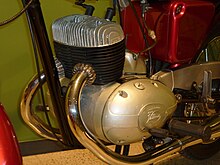
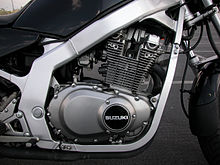
A straight-twin engine, also known as an inline-twin, vertical-twin, inline-2, or parallel-twin, is a two-cylinder piston engine whose cylinders are arranged in a line along a common crankshaft.
Straight-twin engines are primarily used in motorcycles; other uses include automobiles, marine vessels, snowmobiles, jet skis, all-terrain vehicles, tractors and ultralight aircraft.
Various different crankshaft configurations have been used for straight-twin engines, with the most common being 360 degrees, 180 degrees and 270 degrees, but rarely use 450 degrees and 90 degrees
Terminology
[edit]The straight-twin layout is also referred to as "parallel-twin", "vertical-twin" and "inline-twin".[1] Some of these terms originally had specific meanings relating to the crankshaft angle or engine orientation; however, they are often also used interchangeably.[1][2]
In the United Kingdom, the term "parallel-twin" is traditionally used for engines with a crankshaft angle of 360 degrees, since the two pistons are in the same direction (i.e. parallel to each other).[citation needed] "Vertical-twin" was used to describe engines with a crankshaft angle of 180 degrees,[citation needed] which causes the pistons to travel in opposite directions. The terms "straight-twin" and "inline-twin" were used more generically for any crankshaft angle.
For motorcycles, "inline-twin" has sometimes referred to either a longitudinal engine orientation (i.e. with the crankshaft in line with the chassis)[3][4] or a U-engine (tandem twin) where the cylinders are arranged longitudinally in the chassis (although the two crankshafts are actually oriented transversely).[5]
Design
[edit]Compared with V-twin engines and flat-twin engines, straight-twins are more compact, a simpler design and cheaper to produce.[6] Straight-twin engines can be prone to vibration, either because of the irregular firing interval present in 180° crank engines or the large uncountered reciprocating mass in 360° crank engines. Inline-twins also suffer further from torsional torque reactions and vibration.[7]
Crankshaft angle
[edit]
The most common crankshaft configurations for straight-twin engines are 360 degrees, 180 degrees and 270 degrees,[8][9][10] and even can 90 degrees and 450 degrees but uncommon.
- 360 degrees
In an engine with a 360 degree crankshaft, both pistons move up and down at the same time. However, the firing interval is offset between cylinders, with one of the cylinders firing during the first crankshaft rotation and then the other cylinder in the following rotation. This set up results an even 360 degree firing interval unlike other crank configurations in inline twin engines. The 360 degree engines can use a single ignition system for both cylinders, using a wasted spark system.
The imperfect primary balance is as per a single-cylinder engine of equivalent reciprocating mass. Early engines attempted to reduce vibration through counterweights on the crankshaft; however, later methods also included balance shafts and a separate weighted connecting rod. Compared with a single-cylinder engine, the more frequent firing interval (360 degrees compared with 720 degrees) results in smoother running characteristics, despite the similar dynamic imbalance.
From the 1930s, most British four-stroke straight-twin motorcycle engines used a 360 degree crankshaft,[11] since this avoided the uneven intake pulsing of other configurations, thus preventing the need for twin carburettors. In the 1960s, even though Japanese motorcycles mostly switched to 180 degree crankshafts for engines sized from 250 to 500 cc, various smaller and larger engines continued to use a 360 degree crankshaft. Vibration was less of an issue for smaller engines, such as the 1965 Honda CB92 and 1979 Honda CM185. Larger engines, such as the 1969 Yamaha XS 650 and 1972 Yamaha TX750, often used balance shafts to reduce the vibration.[12] The later 1978–1984 Honda CB250N/CB400N engines also used a 360 degree crankshaft, as does the 1989 Yamaha XTZ750 Super Ténéré. The 2008 BMW F series parallel-twin motorcycles also use 360 degree crankshafts, with a third "vestigial" connecting rod (acting as a counterbalance) and a rev limit of 9,000 rpm to reduce vibrations.[13] In 2009 Fiat launched Multiair inline twin car engines that use 360 degree crankshaft which relied on balance shafts to reduce the vibrations.
- 180 degrees
In an engine with a 180 degree crankshaft, one piston rises as the other falls. In a four-stroke engine, the firing interval is uneven, with the second cylinder firing 180 degrees after the first, followed by a gap of 540 degrees until the first cylinder fires again. The uneven firing interval causes vibrations and results in a 'lumpy' power delivery. A 180° engine also requires a separate ignition system for each cylinder.
Perfect primary balance is possible with a 180 degree straight-twin engine; however, the design creates a rocking couple which requires use of a balance shaft to reduce the vibration. A 180 degree straight-twin engine has a secondary imbalance (similar to an inline-four engine); however, the lower reciprocating mass means that this often does not require treatment.
A 180° crankshaft engine suffers fewer pumping losses than a 360° twin, because displacement of the crankcase is relatively unchanged as the pistons move.
In the 1960s, Japanese motorcycle manufacturers favoured the use of 180 degree crankshafts, since the increased smoothness allowed higher rpm and thus higher power outputs. For example, the 1966 Honda CB450 180 degree crankshaft engine has a similar power output to contemporary British 360 degree crankshaft engines, despite having a smaller displacement of 450 cc compared with 650 cc.[14][15][16] Both the 1973 Yamaha TX500 and the 1977 Suzuki GS400 had a 180 degree crankshaft and a balance shaft. Since 1993, most Honda straight-twin motorcycle engines use 180 degree crankshafts.
Two-stroke engines typically use a 180 degree crankshaft, since this results in two evenly-spaced power strokes per revolution. The fundamental frequency of vibration is twice that of an equivalent single-cylinder engine; however, the amplitude is halved.[17] Two-stroke engines that do not use a 180 degree crankshaft include the 1972 Yankee.
- 270 degrees
In an engine with a 270 degree crankshaft, one piston follows three quarters of a rotation behind the other. This results in an uneven firing interval where the second cylinder fires 270 degrees after the first, followed by a gap of 450 degrees until the first cylinder fires again. This is the same pattern as a 90 degree V-twin engine, and both configurations have a similar 'pulsing' exhaust sound as a result. The pistons in a 270 degree straight-twin engine are never both stationary at the same time (as per a 90 degree V-twin engine), thereby reducing the net momentum exchange between the crank and pistons during a full rotation.
An imperfect primary balance is created in a 270 degree straight-twin engine, due to a combination of free force and rocking couple; a balance shaft is often used to compensate for this. The secondary balance of a 270 degree engine is perfect; however, the configuration does result in an unbalanced rocking couple.
The first production 270 degree straight-twin motorcycle engines were fitted to the 1996 Yamaha TRX850 and Yamaha TDM.[9][18][10] Later examples include the 2009 Triumph Thunderbird, 2010 Norton Commando 961, 2012 Honda NC700 series, 2014 Yamaha MT-07, 2016 Triumph Thruxton 1200 and 2018 Royal Enfield Interceptor 650 & Continental GT. This architecture is proving popular among manufacturers, which are upgrading models that were previously equipped with other engine types, such as the 2016 Honda Africa Twin (formerly a V-twin), 2023 Honda Hornet (formerly an inline-4) or 2023 V-Strom 800 (the older design being equipped with a V-twin).
- 90 degrees
In an engine with a 90 degree crankshaft, one piston follows one quarters of a rotation behind the other. This results in an uneven firing interval where the second cylinder fires 90 degrees after the first, followed by a gap of 630 degrees until the first cylinder fires again. thereby reducing the net momentum exchange between the crank and pistons during a full rotation.
An imperfect primary balance is created in a 90 degree straight-twin engine, due to a combination of free force and rocking couple; a balance shaft is often used to compensate for this, probably similar like a 270 degree straight-twin. The secondary balance of a 90 degree engine is probably perfect similar like a 270 degree; however, the configuration does result in an unbalanced rocking couple.
Motorcycle which use 90 degree straight-twin are doesn't exist for now, probably will exist on year 2030s or future.
- 450 degrees
In an engine with a 450 degree crankshaft, one piston follows full and one quarters of a rotation behind the other. This results in an uneven firing interval where the second cylinder fires 450 degrees after the first, followed by a gap of 270 degrees until the first cylinder fires again. Probably this is the same pattern as a Ducati L-twin engine (especially Ducati Panigale 1199 and Ducati Panigale 1299), and both configurations have a similar 'pulsing' exhaust sound as a result. thereby reducing the net momentum exchange between the crank and pistons during a full rotation. Probably this is opposite pattern of 270 degree crankshaft.
An imperfect primary balance is created in a 450 degree straight-twin engine, due to a combination of free force and rocking couple; a balance shaft is often used to compensate for this, probably similar like a 270 degree straight-twin. The secondary balance of a 450 degree engine is probably perfect similar like a 270 degree; however, the configuration does result in an unbalanced rocking couple.
Same like a 90 degree straight-twin, motorcycle which use 450 degree straight-twin are doesn't exist for now, probably will exist on year 2030s or future.
Main bearings
[edit]Each cylinder in a straight-twin engine has a separate crank pin, unlike V-twin engines which can use a common crank pin for both connecting rods. Most vintage British straight-twin motorcycle engines (such as Triumph, BSA, Norton and Royal Enfield) had two main bearings.[19] Beginning in the late 1950s, most Honda straight-twin engines had four main bearings.[20][21] Subsequent straight-twin engines had four or occasionally three main bearings.[12]
Usage in motorcycles
[edit]History
[edit]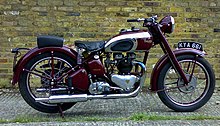

The world's first production motorcycle, the 1894 Hildebrand & Wolfmüller used a straight-twin engine. The cylinders lay flat and forward-facing, with the pistons connected directly to the rear wheel using a locomotive-style connecting rod. In 1903, the Werner Motocyclette became the second production motorcycle model, using a straight-twin engine with vertical cylinders. The Werner engine uses cast-iron cylinders with integral heads, side valves and has a displacement of 500 cc.[22]
The 1938 Triumph Speed Twin was a successful straight-twin motorcycle which also led to straight-twin engines becoming more widely used by other brands. The engine was designed by Edward Turner and Val Page, and was initially used in the 1933 Triumph 6/1 sidecar hauler (which won the International Six Days Trial silver medal and the 1933 Maudes Trophy).[23] During the development of the engine, it was found that a 360 degree crank angle was better suited to the use of a single carburettor than a 180 degree crank angle.[24]
Following the trend created by the Triumph Speed Twin, the most common design used by British motorcycle manufacturers until the mid-1970s was a four-stroke straight-twin engine with a 360 degree crankshaft.[25][26] The manufacturers producing these motorcycles included BSA, Norton, Triumph, Ariel, Matchless and AJS. Straight-twin engines were also produced by Italian and German manufacturers,[27][28][29] along with the American manufacturer Indian.[30]
In 1949, the AJS E-90 Porcupine won the 500 1949 Grand Prix World Championship, becoming the first and only straight-twin motorcycle to win the championship. This engine is one of few four-stroke straight-twins to use cylinders oriented horizontally rather than vertically.[31]
Since the 2000s, BMW and several Japanese manufacturers have continued to produce straight-twin engines, mostly for middleweight models.[32] Several large scooters have also used straight-twin engines, such as the 2001 Yamaha TMAX[33] and the 2001 Honda Silver Wing.[34] Straight-twin engines are also used in motocross sidecar racing.[35]
Transverse-engined models
[edit]
Many large British motorcycles from 1945 to the 1960s used a straight-twin transverse engine (i.e. oriented with the crankshaft perpendicular to the frame), such as the Triumph Bonneville and Norton Commando. This layout is well suited to air-cooling, since both cylinders receive equal airflow and the exhaust can exit in the well-cooled location at the front of each cylinder.[36]
The transverse-engine straight-twin design has been largely replaced by V-twin engines; however, the straight-twin design has the advantage of easier packaging of ancillaries (such as the air-filter, carburettor and ignition components), which also improves access to ancillaries for maintenance/repairs.[37] A straight-twin engine using a 270 degree crankshaft can have a similar sound and feel to a V-twin engine with an uneven firing order.
Longitudinal-engined models
[edit]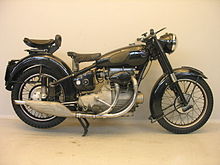
Longitudinal engine straight-twin motorcycles are less common; however, examples include the 1930–1938 Dresch Monobloc[38] and the 1949–1956 Sunbeam S7 and S8.[39][40]
This engine orientation allows for a motorcycle as narrow as a single-cylinder engine,[41] which reduces the aerodynamic drag, especially for the purpose of motorcycle racing. However, the main disadvantage for air-cooled engines is that the rear cylinder runs hotter than the front cylinder.[7][42]
Usage in automobiles
[edit]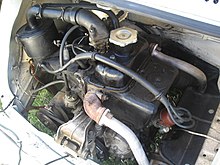
Although two-cylinder engines are quite uncommon in cars, the straight-twin layout has been used for several automobile engines over time.
The first known straight-twin engine was a variant of the Daimler Motors' Phoenix engine introduced in 1895; these engines were used in Panhard cars that year.[43] Another early straight-twin engined car was the 1898 Decauville Voiturelle, which used a pair of cylinders taken from a de Dion model mounted fore and aft and positioned below the seat.[44]
Straight-twin engines have been used in various small cars, such as the 1957 Fiat 500, 1958 Subaru 360, 1958 NSU Prinz,[45] 1962 Mitsubishi Minica, 1967 Honda N360, 1970 Honda Z600, 1972 Fiat 126,[46][47] 1988 VAZ Oka,[48] 1988 Dacia Lăstun,[49] 1980 Daihatsu Cuore,[50] and the 2008 Tata Nano.[51]
As of January 2024, petrol straight-twin engines used in production cars currently just include the Fiat TwinAir engine (used in various models from Fiat, Lancia and Alfa Romeo).
The Piaggio Porter made use of a diesel straight-twin engine until 2020.[52]
Usage in marine vessels
[edit]
Straight-twin engines have been often used as inboard motors, outboard motors and jet pump motors.[53]
In the early 20th century, gaff-rigged British fishing boats such as Morecambe Bay PrawnersLancashire Nobbys would sometimes retrofit an inboard engine, such as the Lister or the Kelvin E2 3.0 litre petrol-paraffin engine.
From the 1950s, manufacturers of outboard motors had settled on the use of the basic inline engine design, cylinders stacked on top of each other with the crankshaft driving the propeller shaft. The Suzuki 15 outbound motor was introduced in 1989.[54]
Other uses
[edit]
Other uses include tractors (such as various John Deere models until 1960),[55] snowmobiles,[56][57] personal watercrafts,[58][59] and all-terrain vehicles.[60][61][62] Design variations include two-stroke, four-stroke, petrol, diesel,[63] air-cooling, water-cooling, natural aspiration and turbocharging.[64]
Ultralight aircraft, single seat gyro-copters and small homebuilt aircraft have also used straight-twin engines,[65] often using engines originally designed for snowmobiles such as the Hirth 2704 and Cuyuna 430-D.[56][66][67] Purpose-built engines for ultralight aircraft include the Rotax 503 and Rotax 582.[68] Straight-twin engines are sometimes also used in large scale radio-controlled aircraft.[69][70]
See also
[edit]References
[edit]- ^ a b Hunt, Phil; McKay, Malcolm; Wilson, Hugo; Robinson, James (2012), Duckworth, Mick (ed.), Motorcycle: The Definitive Visual History, DK Publishing, Penguin Group, pp. 126, 210, ISBN 978-1-46540-088-8
- ^ Tuttle, Mark Jr. (December 2005), "BMW F800S", Rider, p. 15
- ^ Wilson, Hugo (1995). "Glossary". The Encyclopedia of the Motorcycle. London: Dorling Kindersley. pp. 309–310. ISBN 0-7513-0206-6.
in-line Engine layout in which the cylinders are arranged in a row, and in-line with the wheels of the machine... parallel twin A two-cylinder engine layout in which both cylinders are side by side and mounted across the frame.
- ^ Henshaw, Peter (Jun 15, 2008). "Super Bantam". The BSA Bantam Bible: All Models 1948 to 1971. Veloce Publishing. p. 42. ISBN 978-1-84584-159-1. Retrieved July 13, 2012.
...and the Sunbeam S7, that civilised but low-powered shaft-drive in-line twin that BSA hoped would fill a niche as a gentleman's machine...
- ^ Walker, Mick (2000), Mick Walker's European Racing Motorcycles, Redline Books, ISBN 978-0-95313-113-6
- ^ Taylor, Charles Fayette (19 Mar 1985). The Internal-combustion Engine in Theory and Practice: Combustion, fuels, materials, design. Vol. 2 (2 ed.). MIT Press. ISBN 0-262-70027-1.
- ^ a b Nunney, M. J. J. (31 May 2012). Light and Heavy Vehicle Technology (4, illustrated, revised ed.). Taylor & Francis. ISBN 978-0-75068-037-0.
- ^ American bicyclist and motorcyclist, Volume 6. Cycling Press, 1911
- ^ a b Henshaw, Peter (Sep 15, 2012). "Two–Engine". How Your Motorcycle Works: Your Guide to the Components & Systems of Modern Motorcycles. Veloce Publishing. p. 19. ISBN 978-1-84584-494-3.
Unmachined forging of a 270-degree crankshaft for parallel-twin engine. (Honda)
- ^ a b Ried, Rick (December 2001). "British Heritage, American Style". American Motorcyclist. 55 (12). Pickerington, OH USA: American Motorcyclist Association: 18–20. ISSN 0277-9358.
...the America utilizes a 270-degree crank. That gives the America a lumpier cadence at idle that's a fair replica of a V-twin beat, although updated balancer shafts keep the vibrations under control.
- ^ JAE: the journal of automotive engineering, Volume 2. Institution of Mechanical Engineers (Great Britain). Automobile Division. Automobile Division, Institution of Mechanical Engineers., 1971
- ^ a b Vandenheuvel, Cornelis (18 July 1997). Pictorial History of Japanese Motorcycles. Devon U.K.: Bay View Books. ISBN 1-8709-7997-4.
- ^ Holmstrom, Darwin (4 December 2009). BMW Motorcycles. Brian J. Nelson, photographer. MotorBooks International. ISBN 978-0-76033-748-6. Retrieved 2012-09-10.
- ^ Cutts, John; Scott, Michael (1 August 1991). World's Fastest Motorcycles. Book Sales. ISBN 1-5552-1708-7.
- ^ Clew, Jeff (1 February 2007). Edward Turner: The Man Behind the Motorcycles (illustrated, revised ed.). Dorchester, UK: Veloce Publishing. ISBN 978-1-84584-065-5.
- ^ McDiarmid, Mac (1 January 1995). "Honda CB450 'Black Bomber'". Classic superbikes from around the world. Parragon. pp. 52–53. ISBN 0-7525-1017-7.
- ^ Holcolmb, Hank (October 1964). Juettner, Walter R. (ed.). "Inside Today's Outboards". MotorBoating. 114 (4). New York, NY USA: Hearst: 34–35. ISSN 1531-2623. Retrieved 2013-05-18.
- ^ Cycle World, Volume 46. CBS Publications, 2007
- ^ Barger, Sonny; Holmstrom, Darwin (Jun 8, 2010). Let's Ride: Sonny Barger's Guide to Motorcycling. HarperCollins. ISBN 978-0-06196-426-8.
- ^ Mitchel, Doug (Oct 18, 2005). "1959". Honda Motorcycles: Everything You Need to Know About Every Honda Motorcycle Ever Built. Krause Publications. pp. 12–15. ISBN 978-0-87349-966-8.
- ^ Frank, Aaron (Jul 12, 2003). "Chapter Three: Honda Who?". In Holmstrom, Darwin (ed.). Honda Motorcycles. MotorBooks International. p. 34. ISBN 978-0-76031-077-9.
- ^ http://www.moto-histo.com/france/fr1/fr1.htm%7CMotos Francaises, Werner Brothers Moto Bicyclettes
- ^ Davis, Simon (May–June 2013). "Triumph's First Twin: Triumph 6/1". Motorcycle Classics. Topeka, Kansas, USA: Ogden Publications. p. 2. Retrieved 2014-04-26.
- ^ Davis, Simon (May–June 2013). "Triumph's First Twin: Triumph 6/1". Motorcycle Classics. Topeka, Kansas, USA: Ogden Publications. p. 1. Retrieved 2014-04-26.
- ^ Setright, L.J.K. (1976). Motorcycles. London: Weidenfeld & Nicolson. p. 48. ISBN 0-297-77234-1.
- ^ Brooke, Lindsay (5 January 2003). "Chapter Two: Speed Twin and Tiger 100". Triumph: A Century of Passion and Power. MotorBooks International. pp. 36–37. ISBN 978-0-76030-456-3. Retrieved 2012-09-08.
Stylish, light, responsive, smooth, and refined, the Speed Twin changed the direction of motorcycle design and dominated it for thirty years.
- ^ Wilson 1995, pp. 53, 120, 122
- ^ Bacon, Roy (1990). Norton Dominator Twins. PRC. p. 7. ISBN 1-85648-306-1.
- ^ Oliver, Lance (December 2004). Bill, Wood (ed.). "Parallel Universe". American Motorcyclist. 58 (12). Pickerington, Ohio: American Motorcyclist Association: 13. ISSN 0277-9358. Retrieved 2012-09-08.
- ^ Wilson 1995, pp. 108–109
- ^ Gingerelli, Dain; Everitt, Charles; Michels, James Manning (10 January 2011). 365 Motorcycles You Must Ride. MBI Publishing. p. 8. ISBN 978-0-76033-474-4. Retrieved 2012-09-08.
- ^ Clarke, Massimo (17 April 2010) [2008]. Modern Motorcycle Technology: How Every Part of Your Motorcycle Works. Motorbooks Workshop (English ed.). MotorBooks International. ISBN 978-0-76033-819-3. Retrieved 2012-09-08.
- ^ "Yamaha T-Max (2001-2011)". Motor Cycle News. Bauer Media. Archived from the original on 2010-09-30. Retrieved 2012-09-08.
Engine specification 4 stroke, parallel twin, auto
- ^ "2008 Honda Silver Wing ABS Review". Motorcycle.com. Verticalscope. Jun 12, 2008. Archived from the original on 2010-07-27. Retrieved 2012-07-11.
The engine is no longer an oversized, vibration-prone single but a smooth and reasonably powerful in-line twin.
- ^ Westlake, Andy (15 November 2008). "Chapter 17: Wasp - A Sting in the Tail". Off-Road Giants!: Heroes of 1960s Motorcycle Sport. Dorchester, UK: Veloce Publishing. pp. 117–122. ISBN 978-1-84584-190-4. Retrieved 2013-02-01.
- ^ Coombs, Matthew; Haynes, John; Shoemark, Pete (2002), Motorcycle Basics (2nd ed.), Haynes, p. 1•31, ISBN 978-1-85960-515-8
- ^ "Fast Bike" magazine August 1995 page 20
- ^ "Dresch Monobloc 1930 500cc 2 cyl sv". www.classic-motorcycle.com. Retrieved 13 October 2020.
- ^ 487 cc Sunbeam. Walneck's Classic Cycle Trader, Dominion Enterprises, Dec 1996 reprinted from Classic Bike Magazine, 5 January 1950.
- ^ Watanabe, Laurie; Mitchel, Doug (November 1996). "That magnificent man on his riding machines". Dealernews (Trade Publication). 32 (12).
If you press him, though, Jim is likely to expound on his 1947 S7 Sunbeam – "twin-cylinder, rubber-mounted engine. They were an inline two-cylinder, not crosswise in the frame, like conventional twins are."
- ^ Cocco, Gaetano (2004). "Chapter 11: The Engine". Motorcycle Design and Technology (English ed.). St. Paul, MN USA: Motorbooks International. pp. 117–118. ISBN 0-7603-1990-1. Retrieved 2013-09-09.
In some construction layouts the transverse width is the same as a single-cylinder engine, which allows very narrow frames and bodywork with small frontal areas.
- ^ Brown, Roland (1 September 2003). Ultimate History of Fast Bikes. Parragon. ISBN 978-1-40541-592-7.
- ^ Brazendale (1983). Classic Cars: 50 Years of the World's Finest Automotive Design. Bookthrift. pp. 49, 57. ISBN 0-6710-5103-2. Retrieved 26 April 2014.
- ^ Antique cars Michael Sedgwick, 1980 - 93 pages "The engine, an inline twin, lived in a box like a meat-safe at the rear."
- ^ Caunter, Cyril Francis (1958). The light car: a technical history of cars with engines of less than 1600 c.c. capacity. Science Museum (Great Britain) (Second illustrated ed.). H.M.S.O. ISBN 9780112900030.
- ^ Norbye, Jan P. (1981). The complete handbook of automotive power trains. Tab Books. ISBN 0-8306-2069-9. Retrieved 2013-05-18.
- ^ Norbye, Jan P. (February 1975). Luckett, Hubert P. (ed.). "The new logic in small-car engineering". Popular Science. 206 (2). New York, NY USA: Times Mirror Magazines: 56–59. ISSN 0161-7370. Retrieved 2013-05-18.
- ^ "Noutăți. VAZ 111". Autoturism (1/1989). p. 8.
- ^ Teodor, Pompiliu. "Dacia 500 Lăstun". Autoturism (2/1989). p. 5.
- ^ Mastrostefano, Raffaele, ed. (1985). Quattroruote: Tutte le Auto del Mondo 1985 (in Italian). Milano: Editoriale Domus S.p.A. pp. 233–234. ISBN 88-7212-012-8.
- ^ "World's cheapest car launched: Tata Nano". Autocar. Haymarket Consumer Media. Retrieved 2012-07-12.
The twin-cylinder, 623cc petrol engine powering it drives the rear wheels, and sits directly above them to the right of the rear of the car, with a four-speed manual gearbox immediately to its left.
- ^ "Piaggio Porter Maxxi". piaggioveicolicommerciali.it (in Italian). Retrieved 21 January 2014.
- ^ "2 Stroke International Marine Engines & Jet Pumps" (PDF). jetvee.com. Retrieved 4 April 2018.
- ^ Popular Mechanics – Feb 1989 – Page 109. Vol. 166, No. 2 – 136 pages – Magazine "Also new from Suzuki are the inline twin 15 and the inline 3-cylinder 25. Both are equipped with loop-charging, oil injection and external-mount tilt and trim. The 25 also has pre-atomized oil injection and an overrev limiter."
- ^ Klancher, Lee (13 May 2011). The Art of the John Deere Tractor: Featuring Tractors from the Walter and Bruce Keller Collection. Voyageur Press. ISBN 9780760339497.
- ^ a b Markowski, Michael A. (May 1984). Gilmore, C. P.; Ortner, Everett H. (eds.). "Build your own ultralight? –tips from an expert". Popular Science. 224 (5). New York, NY USA: Times Mirror Magazines: 103–107, 158. ISSN 0161-7370. Retrieved 2012-09-13.
- ^ Snowmobile Service Manual, p. 297, at Google Books Intertec Publishing - 1986 - 488 pages "Engines consist of two types; the axial fan, inline twin and the simultaneous firing opposed twin.
- ^ Taylor, Rich (May 2003). Oldham, Joe (ed.). "Fighter Jets". Popular Mechanics. 180 (5). Hearst Magazines: 114–117. ISSN 0032-4558.
Powered by a turbocharged 4-stroke Parallel Twin that has half the displacement of the Sea-Doo's supercharged GTX, the lightweight Polaris MSX 150 is almost as fast and $2200 less expensive.
- ^ Samson, Jack, ed. (October 1972). "Quieter & Safer: the '73 machines". Field & Stream. 77 (6). New York, NY USA: CBS Publications: S10 – S14. ISSN 8755-8599.
The important power plants will now be 399 to 440cc parallel twins.
- ^ Parsons, Grant (February 2003). Wood, Bill (ed.). "Top Gear: Polaris 600 Sportsman Works Hard and Plays Hard". American Motorcyclist. 57 (2). Pickerington, OH USA: American Motorcyclist Association: 16. ISSN 0277-9358.
Underneath the bodywork, you'll find a 597cc overhead-valve parallel twin with two valves per cylinder, fed by a 34mm carb.
- ^ "Which Big Bore Engine Layout Is Best?". Dirt Trax Magazine. 3 August 2011. Archived from the original on 17 December 2013. Retrieved 6 August 2012.
- ^ "BEST IN CLASS: BEST 2-UP ATV". Dirt Trax Magazine. 9 March 2012. Archived from the original on 17 December 2013. Retrieved 6 August 2012.
- ^ "Emission-compliant diesel engines cover 83 to 1,350 bhp in 10 models." Oil, Gas, & Petrochem Equipment May 2006: 18. General OneFile. Web. 29 June 2012. "Cat petroleum diesels line includes eight inline two, three, and four-cylinder engines
- ^ "PSA fires up two-cylinder turbo". Automotive Engineer. 33 (9): 5. October 2008.
Taking an 1,124cc naturally-aspirated inline-four as a baseline, it selected the inline-twin configuration as offering the lowest friction and thermal losses.
- ^ Cliche, Andre (2001). Ultralight Aircraft Shopper's Guide (8th ed.). Cybair Limited Publishing. pp. G–3 and G–4. ISBN 0-9680628-1-4.
- ^ Machine Design: Volume 54, Issues 1–6; Volume 54, Issues 1–6 1982 "A modified snowmobile power plant, the 30-hp inline twin has been detuned by lowering the compression ratio and modifying the carburetion"
- ^ Berger-Burr's ultralight and microlight aircraft of the world, Volume 16. P.185. Alain-Yves Berger, Norman Burr. Haynes Publishing Group, 1 Jan 1983
- ^ "Operators Manual for Engine Types 447, 503, 582" (PDF) (operators manual). BRP-Powertrain. 2010. Retrieved 2012-10-05.
- ^ "3W-150iR2 Inline Twin". www.aircraftinternational.com. Retrieved 4 April 2018.
- ^ Janson, David R. "Model Engine Designer and Manufacturing Profiles: Taplin Twin". Retrieved 2012-10-05.
